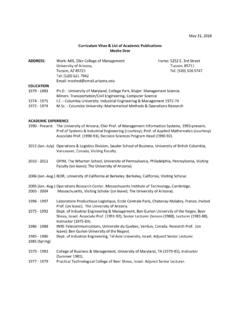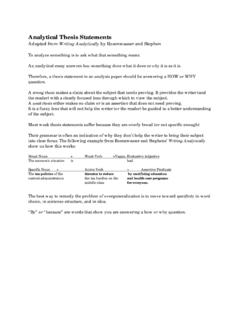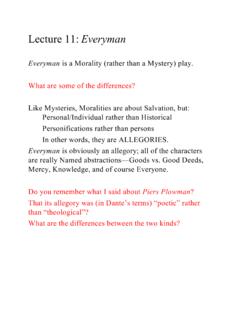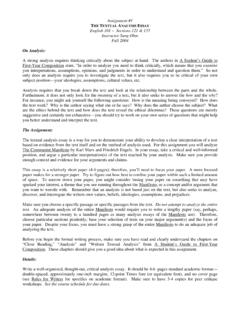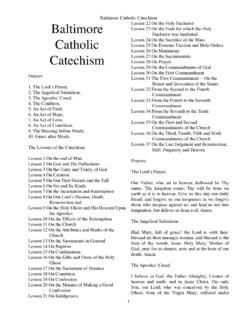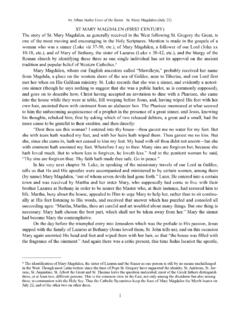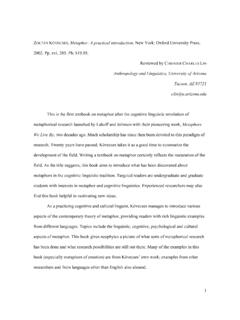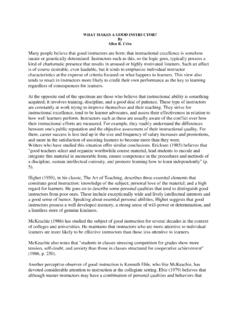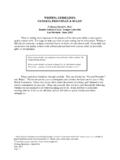Transcription of THE SYNOPTIC GOSPELS - University of Arizona
1 THE SYNOPTIC GOSPELS . MATTHEW MARK LUKE. What does gospel mean? What is a gospel ? What does the word SYNOPTIC mean? NONE of the GOSPELS are eyewitness accounts. The authors were not among the followers of Jesus. The earliest (Mark). was composed about a generation after Jesus's death, presumably because oral memories were beginning to fade &/or were contaminated by varying traditions. The earliest GOSPELS were (probably) Sayings GOSPELS , . collections of Jesus's words with no narrative framework. (The relatively late gospel of Thomas is an example of such a collection.) There are no very early sayings collections that survive, but evidence for the existence of at least one such collection known as Q, for the German Quelle, Source' is found in a substantial body of material, not found in Mark, that Matthew and Luke have in common. The canonical GOSPELS are traditional narratives constructed out of oral materials circulating among various Christian communities after Jesus's death. The stories about Jesus's miracles lend authority to Jesus's teachings.
2 They establish a CONTEXT for interpreting his sayings. For example: Why did Jesus say, The Sabbath was made for humankind, and not humankind for the Sabbath; so the Son of Man is lord even of the Sabbath (Mark 2:27-28)? Mark explains by telling a story: One sabbath [Jesus] was going through the grainfields; and as they made their way his disciples began to pluck heads of grain. The Pharisees said to him, Look, why are they doing what is not lawful on the Sabbath?' And he said to them, Have you never read what David did when he and his companions were hungry and in need of food? He entered the house of God, when Abiathar was high priest, and ate the bread of the Presence, which it is not lawful for any but the priests to eat, and he gave some to his companions' (2:23-26). Matthew and Luke tell the same story (Matt 12:1-8 & Luke 6:1-5), but Matthew adds further qualifying language: Or have you not read in the law that on the sabbath the priests in the temple break the sabbath and yet are guiltless?
3 I tell you, something greater than the temple is here. But if you had known what this means, I desire mercy and not sacrifice,' you would not have condemned the guiltless . (Matthew 12:5-7). Why do you suppose Matthew added that material? Slight adjustments like this have a strong cumulative effect. In general, although the SYNOPTIC GOSPELS tell the same . story, they do so for very different purposes and with very different effects. The names attached to the GOSPELS are traditional; the persons now identified as Mark, Matthew, &. Luke are essentially anonymous. But a good many ideas about their theological/kerygmatic intentions, and about their probable audiences, can be inferred from the way they shape their materials. We'll be looking at some of these distinctive features as we take up each gospel in turn. The SYNOPTIC GOSPELS were not written in the order in which they are now collected. Matthew was long felt to be the most authoritative perhaps because the group that produced it was more numerous or influential than competing groups.
4 Scholars now generally agree that Mark was the earliest written, about a generation (35 years) after Jesus's death, sometime around the year 70 CE. What happened in 70 CE? Matthew was written about a decade later, around 80 CE. Luke-Acts slightly afterward during the decade between 80. and 90 CE. Mark is the shortest gospel . Most of the material in Mark is also found in Matthew and Luke. Matthew and Luke also share a large body of material (Sayings) that is not found in Mark. Finally, Matthew and Luke each contain material (especially traditions about Jesus's birth and his post- resurrection appearances) that is distinctive for each gospel . Scholarly attempts to account for the close literary relationship between the three GOSPELS constitutes what scholars have called the SYNOPTIC Problem. How do we account for the similarities and differences? Once upon a time, Matthew was believed to the source for both Mark (an abridgment) and Luke (a revision). But this way of looking at things posed a number of problems.
5 In general, it was hard to rationalize the differing order &. arrangement of materials in Matthew and Luke if Matthew is assumed to be primary. For example, Why does Luke sometimes agree with Mark's order against Matthew, but never with Matthew's order against Mark? Here is the problem abstractly stated: If Text A contains material X, & Text B contains material X + material Y + Other, & Text C contains material X + material Y + Other;. The simplest account of the relationship between A, B, & C. suggests that B & C both depend on A for the X material. Furthermore, B & C share another common text (the Y. material). This observation led to the formulation of the so- called two-source hypothesis, which posits a collection of Jesus's sayings without any narrative framework. If one rejects the traditional notion that Matthew was the basis of the other two GOSPELS , then the simplest explanation of the literary relationship can be worked out by formula, on the assumption that the shortest, Mark, was the first.
6 : let A = Mark, B = Matthew, and C = Luke;. let the hypothetical collection of Jesus's sayings (the Y. material in Matthew and Luke) be called Q (for the German Quelle, source). As Robertson observes, when one understands that Matthew and Luke made use of Mark for the framework of their GOSPELS , this perspective simplifies amazingly the unfolding of the narrative. (In the Preface to his Harmony of the GOSPELS , 1922). What is a gospel Harmony? The simplified result can be diagramed as follows: MARK Q (c. 50 CE). (c. 70 CE) (Sayings gospel . / \ material also in Thomas). / \ / |. / \ / |. / \ / |. / \ / |. MATTHEW = | (80-85 CE). \ |. Most of Mark + Special Matthew + Q material (Birth & Resurrection Stories) |. Jewish Audience |. \ |. \ |. \. (85-90 CE) LUKE=. Less of Mark + Special Luke + Q. (B & R Stories Parables). Gentile Audienc
